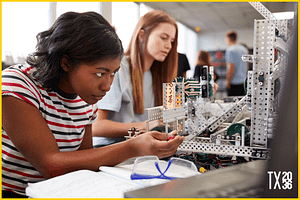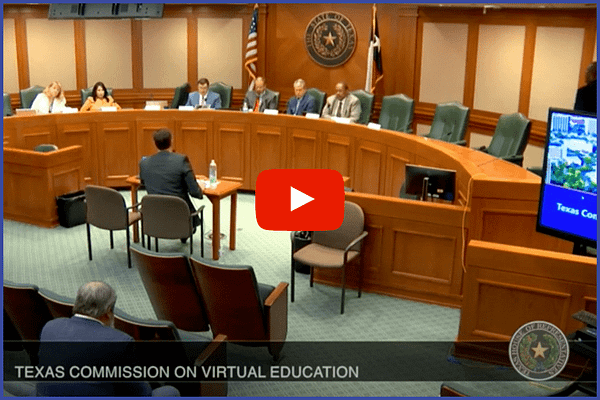The following virtual learning blog is from our Texas 2036 newsletter. To receive this weekly highlight of our work and other important ways to stay engaged, sign up here.
Is virtual learning one of the solutions to meeting Texas’ workforce challenges?
Find out in our three-part summary from Texas 2036 testimony to the Texas Commission on Virtual Education.

The Players 💼 : Created by the Legislature last session, the Texas Commission on Virtual Education is charged with developing and making recommendations for virtual education in the public school system.
Water Cooler Talk 🗣️: We know Texas is facing significant challenges in the labor market. Lesser-known is that it’s driven in part by a lack of postsecondary credentials, such as degrees or workforce-aligned certifications.
- Texas continues to create more jobs than the rest of the nation but many require skills that aren’t readily found in our workforce. This led us to having more jobs available than there are people to fill them.
- For the past few decades, Texas has relied on domestic migration to meet its workforce needs, with newcomers having twice the number of bachelor’s degrees compared to native Texans.
Texans in Need 🏠: The number of good-paying jobs held by Texans with a high school diploma, GED or below has plummeted. These days you need a postsecondary credential to earn a family-sustaining wage.
By the Numbers 📈: COVID learning loss rocked our nation. In Texas, our challenges began building well before the pandemic hit due to leaks in our education-to-workforce pipeline:
- 90%: The amount of Texas high school students who graduate in four years
- 63%: Of those graduates, just over half are college or career ready
- 26%: Within six years of graduation, less than one-third of young folks attain a postsecondary credential
📌 By 2030, 62% of jobs will require education and skills beyond high school.
Fixing the Leaks 🛠: Students should graduate ready for the workforce on Day 1. We prepare them by offering more career training in high school. Virtual education provides immediate access to high-value coursework for students across the state at a much lower cost to districts.

 Part I – Texas Workforce Challenges: How Virtual Learning Can Help 📚
Part I – Texas Workforce Challenges: How Virtual Learning Can Help 📚 Part II – Texas Education & Workforce: Meeting Future Needs 👩🏻🏭
Part II – Texas Education & Workforce: Meeting Future Needs 👩🏻🏭 Part III – Texas College & Career Readiness: Role Virtual Learning Plays 🎓
Part III – Texas College & Career Readiness: Role Virtual Learning Plays 🎓
 Join the conversation:
Join the conversation: